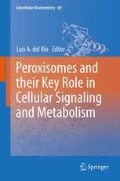Abstract
Although peroxisomes exert essential biological functions, cell type-specific features of this important organelle are still only superficially characterized. An intriguing new aspect of peroxisomal function was recently uncovered by the observation that the peptide hormones β-lipotropin (β-LPH) and β-endorphin are localized to peroxisomes in various human tissues. This suggests a functional link between peptide hormone metabolism and peroxisomes. In addition, because endocrine manifestations that affect steroid hormones are often found in patients suffering from inherited peroxisomal disorders, the question has been raised whether peroxisomes are also involved in steroidogenesis. With this chapter, we will review several crucial aspects concerning peroxisomes and hormone metabolism.
Access this chapter
Tax calculation will be finalised at checkout
Purchases are for personal use only
Abbreviations
- ABC-transporter:
-
ATP binding cassette transporter
- ACTH:
-
Adrenocorticotropic Hormone
- ALDP:
-
Adrenoleukodystrophy protein
- DHEA:
-
Dehydroepiandrostenedione
- IBA:
-
Indole-3-butyric acid
- PC:
-
Prohormone convertase
- POMC:
-
Proopiomelanocortin
- TGN:
-
Trans-Golgi network
- VLCFA:
-
Very long-chain fatty acids
- X-ALD:
-
X-linked adrenoleukodystrophy
- α-MSH:
-
α-Melanocyte-Stimulating Hormone
- β-LPH:
-
β-Lipotropin
References
Akil H et al (1998) Endogenous opioids: overview and current issues. Drug Alcohol Depend 51:127–140
Assies J et al (2003) Effect of dehydroepiandrosterone supplementation on fatty acid and hormone levels in patients with X-linked adrenoleucodystrophy. Clin Endocrinol (Oxf) 59:459–466
Benjannet S et al (1991) PC1 and PC2 are proprotein convertases capable of cleaving proopiomelanocortin at distinct pairs of basic residues. Proc Natl Acad Sci USA 88:3564–3568
Berger J, Gärtner J (2006) X-linked adrenoleukodystrophy: clinical, biochemical and pathogenetic aspects. Biochim Biophys Acta 1763:1721–1732
Brennemann W et al (1997) Testicular dysfunction in adrenomyeloneuropathy. Eur J Endocrinol 137:34–39
Cappa M et al (2011) Is subclinical adrenal failure in adrenoleukodystrophy/ adrenomyeloneuropathy reversible? J Endocrinol Invest 34:753–756
Chiang JY (2004) Regulation of bile acid synthesis: pathways, nuclear receptors, and mechanisms. J Hepatol 40:539–551
Dixit E et al (2010) Peroxisomes are signaling platforms for antiviral innate immunity. Cell 141:668–681
Facciotti F et al (2012) Peroxisome-derived lipids are self antigens that stimulate invariant natural killer T cells in the thymus. Nat Immunol 13:474–480
Ferdinandusse S et al (2009) Bile acids: the role of peroxisomes. J Lipid Res 50:2139–2147
Halabe Bucay A (2008) The role of lipotropins as hematopoietic factors and their potential therapeutic use. Exp Hematol 36:752–754
Höftberger R et al (2010) Peroxisomal localization of the proopiomelanocortin-derived peptides beta-lipotropin and beta-endorphin. Endocrinology 151:4801–4810
Hogenboom S et al (2004a) Mevalonate kinase is a cytosolic enzyme in humans. J Cell Sci 117:631–639
Hogenboom S et al (2004b) Phosphomevalonate kinase is a cytosolic protein in humans. J Lipid Res 45:697–705
Jutras I et al (1997) Two activation states of the prohormone convertase PC1 in the secretory pathway. J Biol Chem 272:15184–15188
Kou J et al (2011) Peroxisomal alterations in Alzheimer’s disease. Acta Neuropathol 122:271–283
Kovacs WJ et al (2007) Localization of the pre-squalene segment of the isoprenoid biosynthetic pathway in mammalian peroxisomes. Histochem Cell Biol 127:273–290
Lu JF et al (2007) The role of peroxisomal ABC transporters in the mouse adrenal gland: the loss of Abcd2 (ALDR), Not Abcd1 (ALD), causes oxidative damage. Lab Invest 87:261–272
Mertani HC, Waters MJ, Morel G (1996) Cellular trafficking of exogenous growth hormone in dwarf rat pituitary. Neuroendocrinology 63:257–268
Morel G (1994) Internalization and nuclear localization of peptide hormones. Biochem Pharmacol 47:63–76
O’Connell Y, McKenna TJ, Cunningham SK (1996) beta-Lipotropin-stimulated adrenal steroid production. Steroids 61:332–336
Petroni A et al (2000) Testosterone metabolites in patients reduce the levels of very long chain fatty acids accumulated in X-adrenoleukodystrophic fibroblasts. Neurosci Lett 289:139–142
Powers JM (1980) A correlative study of the adrenal cortex in adreno-leukodystrophy–evidence for a fatal intoxication with very long chain saturated fatty acids. Invest Cell Pathol 3:353–376
Pritchard LE, White A (2007) Neuropeptide processing and its impact on melanocortin pathways. Endocrinology 148:4201–4207
Stradomska TJ et al (2012) Reproductive function in men affected by X-linked adrenoleukodystrophy/adrenomyeloneuropathy. Eur J Endocrinol 166:291–294
Wanders RJ, Komen JC (2007) Peroxisomes, Refsum’s disease and the alpha- and omega-oxidation of phytanic acid. Biochem Soc Trans 35:865–869
Wichers-Rother M et al (2005) Adrenal steroids in adrenomyeloneuropathy. Dehydroepiandrosterone sulfate, androstenedione and 17alpha-hydroxyprogesterone. J Neurol 252:1525–1529
Zhou Y, Lindberg I (1993) Purification and characterization of the prohormone convertase PC1(PC3). J Biol Chem 268:5615–5623
Zolman BK, Yoder A, Bartel B (2000) Genetic analysis of indole-3-butyric acid responses in Arabidopsis thaliana reveals four mutant classes. Genetics 156:1323–1337
Zolman BK, Nyberg M, Bartel B (2007) IBR3, a novel peroxisomal acyl-CoA dehydrogenase-like protein required for indole-3-butyric acid response. Plant Mol Biol 64:59–72
Acknowledgments
Dr. Isabelle Weinhofer is supported by an FWF Hertha Firnberg fellowship (T 562-B13).
Author information
Authors and Affiliations
Corresponding author
Editor information
Editors and Affiliations
Rights and permissions
Copyright information
© 2013 Springer Science+Business Media Dordrecht
About this chapter
Cite this chapter
Weinhofer, I., Kunze, M., Forss-Petter, S., Berger, J. (2013). Involvement of Human Peroxisomes in Biosynthesis and Signaling of Steroid and Peptide Hormones. In: del Río, L. (eds) Peroxisomes and their Key Role in Cellular Signaling and Metabolism. Subcellular Biochemistry, vol 69. Springer, Dordrecht. https://doi.org/10.1007/978-94-007-6889-5_6
Download citation
DOI: https://doi.org/10.1007/978-94-007-6889-5_6
Published:
Publisher Name: Springer, Dordrecht
Print ISBN: 978-94-007-6888-8
Online ISBN: 978-94-007-6889-5
eBook Packages: Biomedical and Life SciencesBiomedical and Life Sciences (R0)

